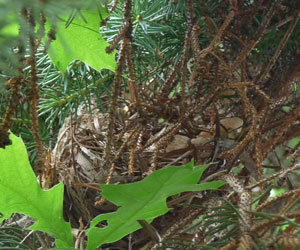 I went out to the cardinal nest that I described in a previous posting. I had watched a week’s worth of intense work by the female cardinal to build the nest, and now two weeks later, I wanted to assess its outcome. I ducked into a reticulum of intertwined blue spruce branches. The nest, a conical basket about 6 inches deep and 3 inches in diameter, was about 12 feet up, and well wedged in between two, horizontal, side branches of the tree. I could see, though, bright blue sky up through the woven materials of the nest. It was empty.
I went out to the cardinal nest that I described in a previous posting. I had watched a week’s worth of intense work by the female cardinal to build the nest, and now two weeks later, I wanted to assess its outcome. I ducked into a reticulum of intertwined blue spruce branches. The nest, a conical basket about 6 inches deep and 3 inches in diameter, was about 12 feet up, and well wedged in between two, horizontal, side branches of the tree. I could see, though, bright blue sky up through the woven materials of the nest. It was empty.
There were no egg fragments on the ground below the nest and no sign that the cardinals had established their clutch here. Maybe the site was too exposed. Maybe all of those visiting jays, crows, and cowbirds had driven the cardinals away. Maybe the nest was too poorly constructed and the pair (the female doing most of the actual work) started another nest armed with the experience of the failure of the first. Nest failures are incredibly common.
Many of the birds around my yard and field, though, have been successful in their reproductive efforts. At the front sunflower seed feeders adult house finches, song sparrows, and cardinals have been perching alongside their fledges and attending to their loud, demanding behaviors for a couple of weeks now. Slowly the fledges learn to feed themselves, but they typically give into weaning most unwillingly.
We were watching a male cardinal crack and feed seeds to a twittering fledge a few days ago. The energy and intensity of the parental care was hypnotic. We suddenly noticed, though, that the fledge was not a cardinal. It had light brown feathers, a striped pale breast, and a flat, crestless head. The fledge was a cowbird that had hatched in the cardinal nest as a nest parasite. The adult cardinal was instinctively caring for this loud, demanding intruder possibly at the cost of its own nestlings and fledglings.
The survival rate of nestlings and fledglings may only be between 50 and 20 percent. The impact of nest parasites like cowbirds along with the susceptibility of the nestlings to disease, exposure, and predators makes the first few weeks of existence very tenuous. Just yesterday, I saw a crow flying off with a struggling robin fledgling in its beak. It was disturbing, but crows have to eat, too.
The magnitude of this nestling and fledgling mortality rate, though, makes any adjustments by the parental birds that increases the chances of survival of their offspring all that more important. Simply making a securely constructed nest and not being satisfied with anything less is an extremely adaptive behavior. Rejecting nest sites because of the presence of predators or possibly because of excessive exposure are also steps that might increase the chances of offspring survival and success. Complex behavior in some species in which one of the parental pair gives up food gathering for the duration of the incubation and stays protectively on the nest entirely dependent on its mate for food is another way that nestling security and survival could be increased although often at the cost of the health and vigor of parental birds.
I hope that the cardinals I watched so closely ended up building a strong nest in a quiet, secure spot and are in the process of rearing a clutch of equally smart cardinals that will go on to do the same next spring. The species will only improve as the generations pass.
